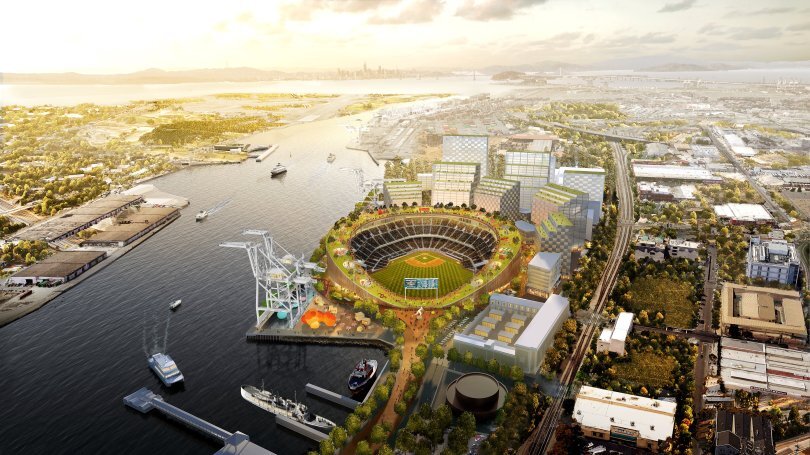After ultimatum, Oakland officials say they will consider A’s ballpark plan
Despite an ultimatum demanding immediate action on a proposed $12-billion waterfront development featuring a new Oakland A’s ballpark, Oakland officials say they’re willing to talk–at their own pace.
It sounds like Oakland officials were caught off guard when the A’s ownership demanded an immediate vote on the proposed Howard Terminal mixed-use development, backed by MLB allowing the team to explore relocation options. In the context of a large urban development, what the Athletics are proposing is audacious and transformative. It will convert a portion of the downtown waterfront from a purely industrial use to a mixed-use environment, it will surely put new stresses on the city’s infrastructure and transport systems, and there are plenty of details to be finalized. It’s no surprise an alliance of businesses opposing the move has a heavy component of shipping and industrial firms—firms with solid investments in the waterfront economy that also sport well-paying jobs. The decision is an important one and will shape the future of the downtown area for decades to come.
And, considering the scope of this project in a state like California, the approval process has been relatively streamlined, with the developers submitting a scaled-down environmental impact statement and going directly to the state for a shorter process. Despite this, the A’s ownership wants an immediate decision on a proposed term sheet–and Oakland officials say they are committed to working with the team on the project, as outlined in a letter from City Council leaders. From the San Francisco Chronicle:
The council’s letter Friday stated “that it is entirely false that the City Council is delaying or refusing to consider the A’s project proposal.” It stated that “many people, including City staff negotiating with the As (sic), have been hard at work developing the work needed to bring a project proposal forward for potential approval.”…
The council’s letter Friday says it was “in the process” of exploring the A’s request for a July vote “when instead MLB announced that apparently you have been given incorrect information that City leadership is refusing to work with the A’s, and you have announced your plan to enable their relocation to a new city.”…
“However, we remain open to working together. It is possible that you didn’t intend to threaten relocation from a city, in the absence of that city’s leadership even being given an opportunity to consider a proposal from the team.”
While other cities have reached out to the A’s after the team was allowed to explore a move, keep in mind relocation talks are usually a tactic designed to extract a new ballpark deal from an existing municipality on the MLB level. Honestly, MLB teams don’t move often. The last MLB franchise move was in 2004, when the Montreal Expos moved to Washington, but there was nothing normal about that process. Before that, the last MLB team relocation came in 1971, when the Washington Senators were moved by Bob Short to Arlington, Texas.
One fact seems to be lost in the discussions of the Howard Terminal development: estimated as a $12-billion project when totally built out, the mixed-use proposal from the A’s would be one of the largest developments in the United States. The ambitious Hudson Yards mixed-use project in New York City was estimated at $20 billion; by comparison, the entire Rockefeller Center development cost an estimated $1.5 billion in 2019 dollars. In the commercial construction/development world, these billion-dollar-plus projects are deemed mega projects, and most are related to transit or pipelines. To put it in perspective: what the Athletics owners are proposing would be the most expensive upcoming mixed-use developments in the United States by a wide margin, even if the $1-billion ballpark were stripped from the project. Now, whether the Howard Terminal project would ever actually hit the $12-billion mark is another issue, and one of the issues being examined by the city. But it’s safe to say that a project of this scale would be heavily debated with or without a ballpark, and it was probably very shrewd of the Athletics ownership to divert attention away from the scope of the project to a discussion of what can be done to keep the A’s in town.





